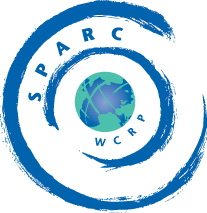 |
Stratospheric Processes And their Role in Climate
|
||||||||
| Home | Initiatives | Organisation | Publications | Meetings | Acronyms and Abbreviations | Useful Links |
![]()
 |
Stratospheric Processes And their Role in Climate
|
||||||||
| Home | Initiatives | Organisation | Publications | Meetings | Acronyms and Abbreviations | Useful Links |
![]()
A.R. Ravishankara, NOAA, Boulder, USA (ravi@al.noaa.gov)
I. Bey (EPFL, Lausanne), P. Forster (University of Reading), C. Johnson (Hadley Center, Met Office), D. Kley (KFA, Juelich), K. Law (University of Cambridge), A. O'Neill (University of Reading), S. Pawson (NASA-Goddard), Th. Peter (ETH, Zurich), J. Pyle (University of Cambridge), V. Ramaswamy (GFDL, NOAA), A. R. Ravishankara (AL, NOAA), M. Schultz (Max-Planck-Institute, Hamburg), T. Shepherd (University of Toronto), and M. Takahashi (University of Tokyo) attended the discussions.
First row left to right: S. Pawson, P. Forster, A.R. Ravishankara
Second row left to right: Th. Peter, T. Shepherd, K. Law, I. Bey, M. Schultz, A. O'Neill,
C. Johnson, M. Takahashi
A.R. Ravishankara presented an overview of the aims of the SPARC interest in the Climate-Chemistry initiative and discussed what is being planned in starting the joint initiative. Each attendee presented a few discussion points that were assigned to them from the following list of topics.
1. Ozone in the Upper Troposphere (UT) and Lower Stratosphere (LS),
2. Condensed matter in UT/LS: Aerosol and Radiation; Cirrus; Chemistry in/on condensed matter,
3. Impact of regional emissions on global state,
4. Tropical Tropopause Layer (TTL),
5. Dynamical Influences,
6. Water Vapour,
7. Current State of GCMs, and
8. Tropospheric chemistry.
Following the presentations and vigorous discussions, it was concluded that crosscutting process related issues and modelling issues should be addressed. These include issues and topics such as:
1. The extent and role of stratosphere-troposphere exchange in controlling the abundances of ozone and other species in the UT and LS. Specifically, an accurate quantification of the STE contribution to tropospheric and upper-tropospheric ozone budget (which is likely to be a function of time and location).
2. The role of convection (both deep and warm) in controlling the water vapour abundance and redistribution of chemical constituents.
3. The state of radiative transfer codes in calculating heating rates and photolysis rates.
4. The use of variability in observations and in models to identify and diagnose roles and contributions of processes. An assessment of the role of inter-annual variability in the circulation patterns affecting the distribution of chemical constituents in the stratosphere and troposphere.
5. The role of Tropical Tropopause Layer (TTL) in climate-chemistry interactions.
6. The role of lightning in the production and distribution of nitrogen oxides.
7. The role of aerosols in chemistry, climate, and their interactions. The processing of aerosol in the atmosphere and their impact on chemistry and climate. Understanding and representing microphysical processes in numerical models.
8. The age of air in the UT - its definition, determination, and use.
9. The use of numerical models to analyse the feasibility of process studies and quantification of key processes. Understanding of microphysics and their incorporation in numerical models.
10. Determination of the fundamental parameters in kinetics, heterogeneous chemistry (specifically aerosols and ice in UT), photolytic processes, spectroscopy, and optical properties via laboratory studies.
It was concluded that these are a very large number of issues and topics to be jointly studied by the SPARC-IGAC community. Furthermore, these issues were not prioritised at this meeting. Once the IGAC community can look at these issues and topics and decide on their interests, the top priorities for the joint initiative should be very apparent. In facilitating this process, the conclusions of this discussion group will be shared with the IGAC co-chairs, then A.R. Ravishankara and A. O'Neill will make a presentation to the IGAC community at the IGAC symposium in Crete in September. Before the meeting, a venue and date for a joint workshop with IGAC will be decided in consultations with the IGAC co-chairs.
![]()